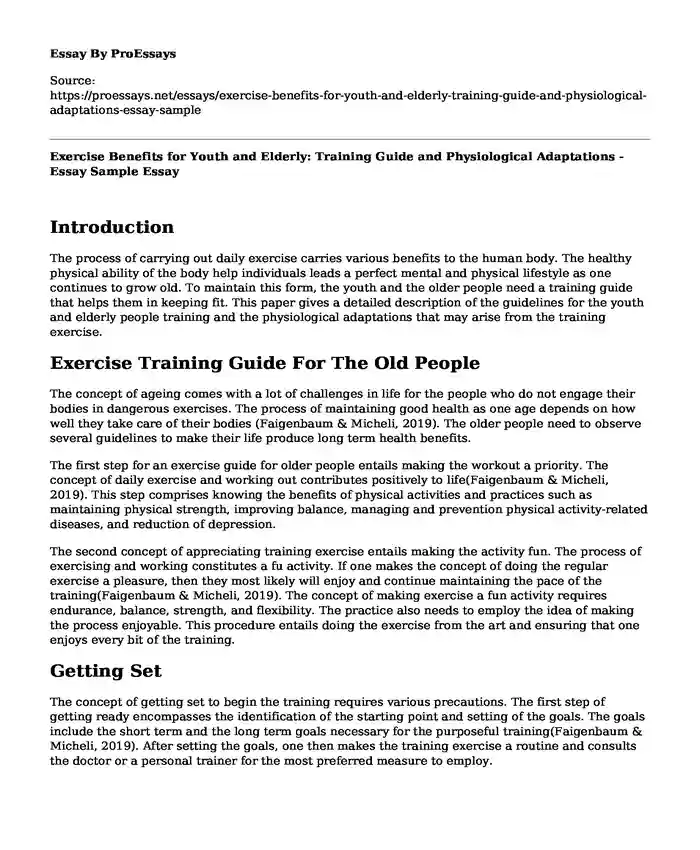Introduction
The process of carrying out daily exercise carries various benefits to the human body. The healthy physical ability of the body help individuals leads a perfect mental and physical lifestyle as one continues to grow old. To maintain this form, the youth and the older people need a training guide that helps them in keeping fit. This paper gives a detailed description of the guidelines for the youth and elderly people training and the physiological adaptations that may arise from the training exercise.
Exercise Training Guide For The Old People
The concept of ageing comes with a lot of challenges in life for the people who do not engage their bodies in dangerous exercises. The process of maintaining good health as one age depends on how well they take care of their bodies (Faigenbaum & Micheli, 2019). The older people need to observe several guidelines to make their life produce long term health benefits.
The first step for an exercise guide for older people entails making the workout a priority. The concept of daily exercise and working out contributes positively to life(Faigenbaum & Micheli, 2019). This step comprises knowing the benefits of physical activities and practices such as maintaining physical strength, improving balance, managing and prevention physical activity-related diseases, and reduction of depression.
The second concept of appreciating training exercise entails making the activity fun. The process of exercising and working constitutes a fu activity. If one makes the concept of doing the regular exercise a pleasure, then they most likely will enjoy and continue maintaining the pace of the training(Faigenbaum & Micheli, 2019). The concept of making exercise a fun activity requires endurance, balance, strength, and flexibility. The practice also needs to employ the idea of making the process enjoyable. This procedure entails doing the exercise from the art and ensuring that one enjoys every bit of the training.
Getting Set
The concept of getting set to begin the training requires various precautions. The first step of getting ready encompasses the identification of the starting point and setting of the goals. The goals include the short term and the long term goals necessary for the purposeful training(Faigenbaum & Micheli, 2019). After setting the goals, one then makes the training exercise a routine and consults the doctor or a personal trainer for the most preferred measure to employ.
Starting The Training Exercise
When older people decide to begin the training exercise program, there exist various considerations they should put in place(Faigenbaum & Micheli, 2019). There exist various key strategies in succeeding the exercise process. These include incorporating physical activities in daily life, trying different types of exercise, planning for breaks in the routine, making the exercise process safe and adding new events.
Training For The Youths
The young age comprises the essential span of human life. This stage constitutes the age when the body proves most active and needs regulation to maintain a healthy body. The suggestions from medication suggest that youths should spend at least sixty minutes engaging in moderate to vigorous activity daily. The training programs involve a series of steps necessary to ensure that teenagers realise their potential in exercising.
The process of exercise training involves competently supervised and designed training exercise programs. The process constitutes physical conditioning which employs a series of loads and training modern equipment (National Institute on Aging, 2009). The instructions and supervision apply training and exercise experts who guide the interested parties.
Emotional Maturity
The concept of emotional maturity proves necessary in enabling the trainees to follow the rules and regulations to the letter (Hattersley, Hembrough, Khan, & Maden-Wilkinson, 2019). The success of any activity employs the concept of the need to use the discipline measures and following the expectations to the letter of the program. The youths need to realise that the goal of the training exercises acts to benefit them.
Physiological Adaptations To Exercise
There exist adaptive physiologies in exercise, depending on different parts of the body. These physiological adaptations vary and affect the body differently. To begin with, there exist physiological adaptations in the neural system (Legerlotz, Marzilger, Bohm, & Arampatzis, 2019). The neural and morphological factors contribute to the increment of muscle strength. The knee extension force increases as a result of exercise, making the individual more strong. There also exist rapid muscle force production necessary for essential components of performance
Second, there exists adaptation in the muscular systems that change the functionality parameters of the muscle such as its strength, power and the movement velocity. These adaptions changes relate to the muscle composition, shape, muscle power and architecture. These physiological processes much depend on maturity rates.
The tendinous system also adapts physiologically to training.increasing muscle force resulting in growth and strengths leads to higher strains in the tendinous tissue (Legerlotz et al. 2019). This step makes the tendon prone to injuries, and this concept calls for morphological or material property change in the tendinous composition.
References
D. Faigenbaum, A., & J. Micheli, L. (2019). ACSM Sports Medicine Basics. Retrieved from https://www.acsm.org/docs/default-source/files-for-resource-library/smb-youth-strength-training.pdf?sfvrsn=85a44429_2
Hattersley, C., Hembrough, D., Khan, K., & Maden-Wilkinson, T. (2019). Retrieved from https://www.researchgate.net/publication/329673995_Strength_Training_for_Older_Adults
Legerlotz, K., Marzilger, R., Bohm, S., & Arampatzis, A. (2019). Retrieved from https://www.researchgate.net/profile/Kirsten_Legerlotz/publication/309429437_Physiological_Adaptations_following_Resistance_Training_in_Youth_Athletes_-_A_Narrative_Review/links/5833f8f908ae138f1c0ab4a8.pdf
National Institute on Aging. (2009). Exercise & physical activity: Your everyday guide from the National Institute on Aging.
Cite this page
Exercise Benefits for Youth and Elderly: Training Guide and Physiological Adaptations - Essay Sample. (2023, Mar 20). Retrieved from https://proessays.net/essays/exercise-benefits-for-youth-and-elderly-training-guide-and-physiological-adaptations-essay-sample
If you are the original author of this essay and no longer wish to have it published on the ProEssays website, please click below to request its removal:
- Essay Sample on Difference Between Cliques and Crowds
- Whose Hospital Is Brendan Hospital? - Essay Sample
- Essay on Malariology: Technological Change, Cultural Differences, and Geographies
- Evidence-Based Practice vs. Research: A Comparison Essay
- Effective Communication: A Foundation for Human Existence - Essay Sample
- Access to Water: Essential for Life & Public Health - Essay Sample
- Agenda Setting and Framing - Essay Sample







